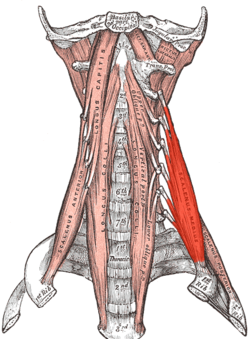- Scalenus medius
-
Scalenus medius The anterior vertebral muscles. (Scalenus medius visible in bottom center-right.) Section of the neck at about the level of the sixth cervical vertebra. Showing the arrangement of the fascia coli. (Scalenus medius visible at center left.) Latin musculus scalenus medius Gray's subject #114 396 Origin C2-C6 Insertion first rib Artery Ascending cervical artery (branch of Inferior thyroid artery) Nerve Ventral rami of the third to eighth cervical spinal nerves Actions Elevate 1st rib, rotate the neck to the opposite side The Scalenus medius, the largest and longest of the three scalene muscles, arises from the posterior tubercles of the transverse processes of the lower six cervical vertebræ. It descendes along the side of the vertebral column to insert by a broad attachment into the upper surface of the first rib, between the tubercle and the subclavian groove. The brachial plexus and the subclavian artery pass anterior to it. Because it elevates the upper ribs, the middle scalene muscle is also one of the accessory muscles of respiration.
See also
- Scalene muscles
- Accessory muscles of respiration
Additional images
External links
This article was originally based on an entry from a public domain edition of Gray's Anatomy. As such, some of the information contained within it may be outdated.
List of muscles of head and neck: the neck (TA A04.2, GA 4.387) Cervical Suboccipital Suprahyoid CN V3 (medial): mylohyoid · anterior belly of digastric
CN VII (lateral): stylohyoid · posterior belly of digastric
C1 (deep): geniohyoidInfrahyoid/strap Fasciae Pharynx pharyngeal constrictor (superior, middle, inferior) · longitudinal (stylopharyngeus, salpingopharyngeus)Larynx cricothyroid · cricoarytenoid (posterior, lateral) · arytenoid (oblique arytenoid/aryepiglottic, transverse arytenoid) · thyroarytenoid (vocal, thyroepiglottic)Categories:- Muscles of the head and neck
- Muscle stubs
Wikimedia Foundation. 2010.




